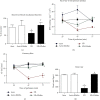Ameliorating Effect of Klotho Protein on Rat Heart during I/R Injury
- PMID: 33123314
- PMCID: PMC7586150
- DOI: 10.1155/2020/6427284
Ameliorating Effect of Klotho Protein on Rat Heart during I/R Injury
Erratum in
-
Corrigendum to "Ameliorating Effect of Klotho Protein on Rat Heart during I/R Injury".Oxid Med Cell Longev. 2022 Jul 4;2022:9781367. doi: 10.1155/2022/9781367. eCollection 2022. Oxid Med Cell Longev. 2022. PMID: 35832489 Free PMC article.
Abstract
An essential procedure for the treatment of myocardial infarction is restoration of blood flow in the obstructed infarct artery, which may cause ischaemia/reperfusion (I/R) injury. Heart I/R injury manifests in oxidative stress, metabolic and morphological disorders, or cardiac contractile dysfunction. Klotho protein was found to be produced in the heart tissue and participate in antioxidation or ion homeostasis. The aim of this study was to examine an influence of Klotho protein on the heart subjected to I/R injury. Wistar rats served as a surrogate heart model ex vivo. Rat hearts perfused using the Langendorff method were subjected to global no-flow ischaemia, and isolated rat cardiomyocytes underwent chemical I/R in vitro, with or without recombinant Klotho protein administration. Haemodynamic parameters of heart function, cell contractility, markers of I/R injury and oxidative stress, and the level of contractile proteins such as myosin light chain 1 (MLC1) and troponin I (TnI) were measured. The treatment of hearts subjected to I/R injury with Klotho protein resulted in a recovery of heart mechanical function and ameliorated myocyte contractility. This improvement was associated with decreased tissue injury, enhanced antioxidant capacity, and reduced release of MLC1 and TnI. The present research showed the contribution of Klotho to cardioprevention during I/R. Thus, Klotho protein may support the protection from I/R injury and prevention of contractile dysfunction in the rat heart.
Copyright © 2020 Agnieszka Olejnik et al.
Conflict of interest statement
The authors declare that there is no conflict of interest regarding the publication of this paper.
Figures







Similar articles
-
Klotho protein contributes to cardioprotection during ischaemia/reperfusion injury.J Cell Mol Med. 2020 Jun;24(11):6448-6458. doi: 10.1111/jcmm.15293. Epub 2020 Apr 21. J Cell Mol Med. 2020. PMID: 32319182 Free PMC article.
-
Klotho Protein Decreases MMP-Mediated Degradation of Contractile Proteins during Ischaemia/Reperfusion Injury to the Cardiomyocytes.Int J Mol Sci. 2022 Dec 7;23(24):15450. doi: 10.3390/ijms232415450. Int J Mol Sci. 2022. PMID: 36555091 Free PMC article.
-
High-intensity interval training increases myocardial levels of Klotho and protects the heart against ischaemia-reperfusion injury.Exp Physiol. 2020 Apr;105(4):652-665. doi: 10.1113/EP087994. Epub 2020 Mar 17. Exp Physiol. 2020. PMID: 32052504
-
Cardioprotective effect of MMP-2-inhibitor-NO-donor hybrid against ischaemia/reperfusion injury.J Cell Mol Med. 2019 Apr;23(4):2836-2848. doi: 10.1111/jcmm.14191. Epub 2019 Feb 7. J Cell Mol Med. 2019. PMID: 30729745 Free PMC article.
-
Shenxian-Shengmai Oral Liquid Reduces Myocardial Oxidative Stress and Protects Myocardium from Ischemia-Reperfusion Injury.Cell Physiol Biochem. 2018;48(6):2503-2516. doi: 10.1159/000492688. Epub 2018 Aug 17. Cell Physiol Biochem. 2018. PMID: 30121659
Cited by
-
Expression of atrial‑fetal light chains in cultured human cardiomyocytes after chemical ischemia‑reperfusion injury.Mol Med Rep. 2021 Nov;24(5):770. doi: 10.3892/mmr.2021.12410. Epub 2021 Sep 7. Mol Med Rep. 2021. PMID: 34490485 Free PMC article.
-
Klotho inhibits IGF1R/PI3K/AKT signalling pathway and protects the heart from oxidative stress during ischemia/reperfusion injury.Sci Rep. 2023 Nov 20;13(1):20312. doi: 10.1038/s41598-023-47686-5. Sci Rep. 2023. PMID: 37985893 Free PMC article.
-
In Vivo Study on Doxycycline Protective Mechanisms during Myocardial Ischemia Injury in Rats.Biomedicines. 2024 Mar 13;12(3):634. doi: 10.3390/biomedicines12030634. Biomedicines. 2024. PMID: 38540247 Free PMC article.
-
Klotho in age-related cardiovascular diseases: Insights into mitochondrial dysfunction and cell death.Int J Cardiol Heart Vasc. 2025 Mar 8;57:101629. doi: 10.1016/j.ijcha.2025.101629. eCollection 2025 Apr. Int J Cardiol Heart Vasc. 2025. PMID: 40129656 Free PMC article. Review.
-
Antioxidants in Arrhythmia Treatment-Still a Controversy? A Review of Selected Clinical and Laboratory Research.Antioxidants (Basel). 2022 Jun 2;11(6):1109. doi: 10.3390/antiox11061109. Antioxidants (Basel). 2022. PMID: 35740006 Free PMC article. Review.
References
-
- Antman E. M., Anbe D. T., Armstrong P. W., et al. ACC/AHA guidelines for the management of matients with ST-elevation myocardial infarction—executive summary: a report of the American College of Cardiology/American Heart Association Task Force on Practice Guidelines (writing committee to revise the 1999 guidelines for the management of patients with acute myocardial infarction) Circulation. 2004;110:588–636. - PubMed
MeSH terms
Substances
LinkOut - more resources
Full Text Sources

